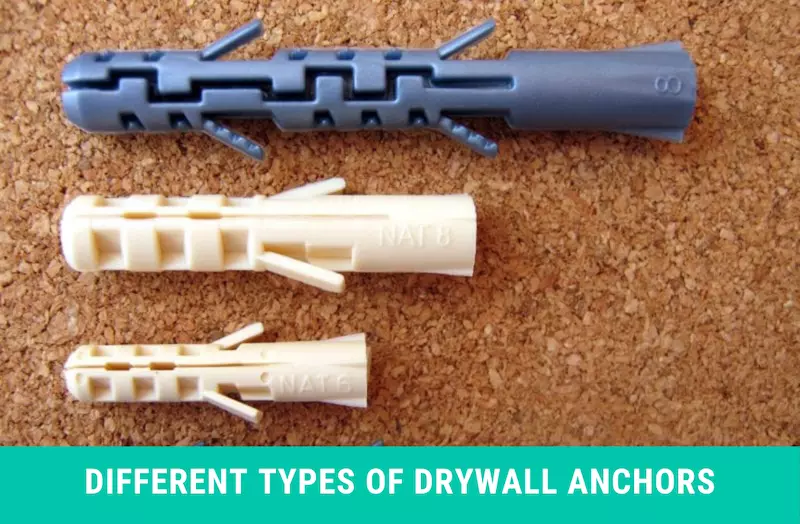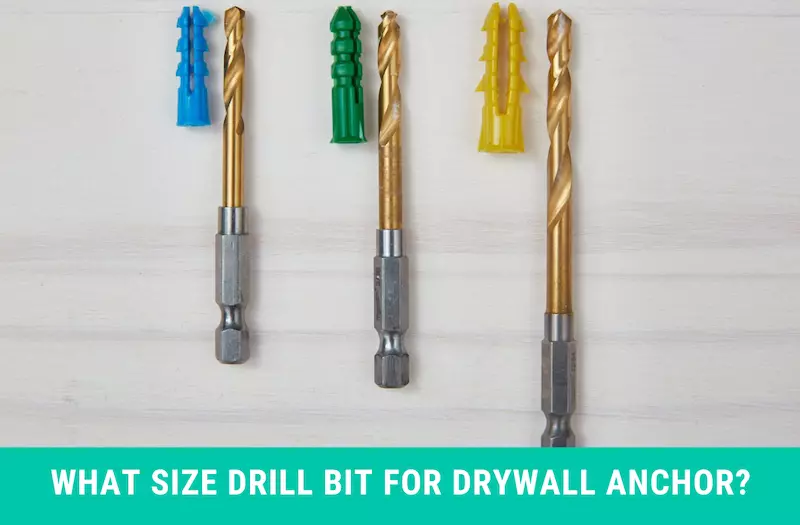Drywall is the most common constructional object for interior decoration. People prefer it for easy and quick installation. Not only these but also it can carry lightweight to heavy-weighted objects. So, we often need to drill the board and use screws. When we talk about drilling, the issue of drill bits for drywall anchors also comes as usual. Drill bits size is a concerning matter because if a bit makes an inappropriate hole, naturally the screw and anchor won’t be assembled in the wall correctly. So, the concerning issue is “what size drill bit for drywall anchors?”
Usually, drywall anchors or wall plugs help a screw to adhere safely to drywall. Nevertheless, you can’t use randomly any anchors with any size drill bit. Since we frequently use drywall for our interior, we should know the appropriate drill bit sizes.
I’ll discuss the bit sizes you can use for different drywall anchors, anchors types you can use for drywall, and some other important tips and tricks to make your drilling journey easy.So let’s get into the article and have some must-have knowledge about drill bits for drywall anchors.
Drywall Anchor Drill Bit Size Chart
Nowadays, in almost all houses, it’s common to have a drill machine. In the machine. the bit is an important part. Generally, a drill bit works by applying heavy circulation torques. Torques mean twisting or rotational force. Hence, a bit is directly responsible for any hole size.
You must know there are numerous sizes of drill bits available on the market. Some are small that are used to load lightweight on the wall and some are used to support heavy weight. Different sizes of drill bits that are commonly used for drywall anchors are-
| Drill Bit Sizes for Drywall | Screw size | ||
| In Inch (Fraction) | In Inch (Decimal) | In Metrics | |
| ⅛” | 0.13” | 3 mm | #4 to #12 |
| 3/16” | 0.18” | 5 mm | |
| ¼” | 0.25” | 6 mm | |
| 5/16” | 0.31” | 8 mm | #14 to #16 |
| ⅜” | 0.38” | 10 mm | |
| ½” | 0.50” | 13 mm | |
| ⅝” | 0.63” | 16 mm | |
| ¾” | 0.75” | 19 mm | |
| ⅞” | 0.88” | 22 mm | |
| 1” | 1” | 25 mm |
N.B- The anchor size and drill bit size must be in the same diameter. Example: If you take a ½” anchor, the bit size’ll be the same.
Among those sizes, ⅜” or 10 mm and ½” or 13 mm are the two most common sizes.
How Big should be a Drill Bit for Drywall anchor?
Since you can always make a hole bigger but not the other way around, you should always start with the smaller one. Drillers frequently utilize a 1/2″ drill bit to install SnapToggle and FlipToggle anchors. But in general, the drill should be slightly wider than the anchor and narrower than the flat head that secures the object while you tighten the screw.

It’s also important to match the thickness of your drywall. If the shaft is too lengthy, the blank section will extend past the back of the drywall, and everything will be unsecured. If it’s too short, the wallboard will experience considerable damage. Therefore, the blank shaft should be between 75% and 99% of the thickness of the drywall or wallboard.
Which type of Drill Bits should you choose for Drywall Anchors?
To select a perfect drill bit, you have to know the types and toughness of the surface on which you want to make holes. So, as a surface, how is drywall? The fair matter is that you can use any type of drill bit on your drywall anchors for its comparatively soft nature. Basically, drywall or wallboard whatever we call it is made from gypsum with some other additives like fiber, plasticizer, foaming ingredients, etc.
Whatever, we use it for interior or ceiling decoration as an alternative to plaster. The good thing is that it can also hold a heavyweight like up to 100 pounds if it’s installed properly.
Different Types of Drill Bits for Drywall
You have to get anchors that have the capacity to hold the weight of the object to be secured into your sheetrock or drywall.
Anchors of various metals and types are available in the market and are often used in drywall. Some of these anchors are made specifically for drywall and others are made to be used on a variety of surfaces. Different types, materials, and shapes of drywall anchors are used as needed. These are discussed below:

Toggle bolts
Toggle bolt or butterfly anchor are familiar heavy-duty drywall anchor that is used to bear up to 50 pounds. It uses wings to keep the fastener in form. There are many sizes available for toggle bolts. ⅛”, 3/16″, and ¼” are the most common sizes that are commonly used for different thicknesses of drywall.
Hollow-wall anchors
The hollow wall is a vibration-resistant steel anchor which can be installed easily. Especially, it’s designed for hollow walls as drywall. So, it can carry up to 100 pounds with no issue. Such anchors provide more safety for the precious hanging objects on the wallboard.
Winged or butterfly plastic anchors
This plastic anchor is also durable and effective to hold medium-weight objects like frames, towel holders, etc. Specifically, the anchor is designed for drywall. It holds the screw expanding its wings on the opposite side of the board or wall.
Alligator Anchors
Basically, alligator anchors are designed for both solid and hollow mediums. So it also works for drywall. Its shape protects the screw from spinning and countersinking. The other good sides of the anchor are-
- It’s a vibration-resistant anchor.
- You can fix any greatest-size screw on it.
- There’s no risk of corrosion.
- You can remove the screw and replace it on the same anchor whereas the holding capability won’t be damaged.
- The most positive side is that it can hold the screw tightly even after with unsuitable screw sizes.
Plastic-expansion Anchors
If you need to hang lightweight less than 20 pounds, plastic expansion anchors are another best choice. The anchor works as a jacket to hold the screw. It expands inside the mediums and adheres to the walls. Such anchors also need a small hole to install perfectly. Overall, it’s best for holding frameworks.
Self-drilling Anchors
It’s a kind of hollow steel bar or rod that is used in place of the drill bit. Actually, it drills the drywall and remains fixed there. Although it can be used in drywalls, it’s more effective and designed for unstable mediums. Whatever it’s familiar for its bending strength.
Strap Toggle Anchors
Another strengthful anchor is the strap toggle anchor. It’s also designed for hollow substances. So, you can easily use it in drywalls. I especially prefer the anchos for several reasons-
- You can install it and remove it even after installation.
- The anchor can be placed in tiny holes.
- No screw is needed to install it.
Sleeve Anchors
If you want to hang something heavy on your drywall, sleeve anchors are best for it. It’s a heavy-duty and versatile anchor as well. Besides, it’s corrosion-free, well-fitted anchors. Whatever it’s more effective in concrete than drywall
How to Install Drywall Anchors
So, here is how we should install drywall anchors. Proper anchor installation will securely keep the objects that you want to keep in the drywall.

- Mark the location on the drywall where you will do the drilling in order to ensure a smooth drilling platform.
- Drill a pilot hole first, and ensure to use the appropriate bit for the anchor size.
- Choose the best anchor type for your needs based on the screw type.
- Plastic or molly anchors are made, requiring a firm and secure move.
- When they are toggle bolts, you will hear a snap as your anchor is reached.
- If the anchors become jammed, use your hammer to gently tap them.
- Now, carefully fasten the screws to prevent the object from slipping.
3 Magical Tips to Fix The Drywall Anchor
- Since you can make it larger later, always start small.
- Increase the size of the hole if you discover that it is insufficiently small to accommodate the chosen anchor.
- If you purchase spackling and fill the pre-drilled hole, the problem of the hole is too large will be effortlessly resolved.
FAQs on What Size Drill Bit for Drywall Anchor
What size hole do I drill for 1/2-inch anchor?
Make sure the necessary embedment standards of 2 to 1/4″ are met by drilling the hole 1/2″ deeper than the anchor will break the concrete. It will be much better to use bits with carbide tips.
What size drill bit would you use to install 3/8 anchor bolts?
Use a carbide-tipped bit to drill a hole into the concrete that is 3/8″ larger than the diameter of the anchor. However, be careful to drill the hole at least 1/2 inch deeper than the anchor’s length.
Can drywall hold screws?
If you install any hardware without any additive coat or reinforcement in drywall, there is a chance of coming out of the wall. So, when you decide to put a screw to hold even less weight, you should use any type of anchor for safety.
What size hole to drill for wall anchors?
Always make a little smaller hole than the anchor or bit size. ½” hole is the most applicable hole for wall or drywall anchors. Actually, it depends on someone’s needs.
Do you hammer wall anchors all the way in?
You have to hammer or beat an anchor till it goes thoroughly into the hole. Your anchor won’t work nicely if it’s not installed appropriately. So, a few gentle taps work really well.
Final Section
As drywall is a foamy type material, so with any bits you can use any. Although we all don’t want to make a useless hole in our decorative wall. This is why I tried to discuss what size drill bits snugly go for drywall anchors. You have to decide what you want to hold on to the screw. If things are more weighted then take a little big size bit to drill and a small size bit for lightweight. Hope you’ll be benefited from the article
